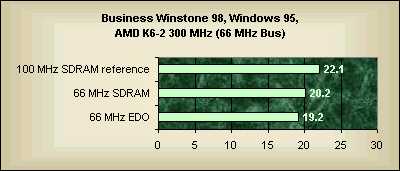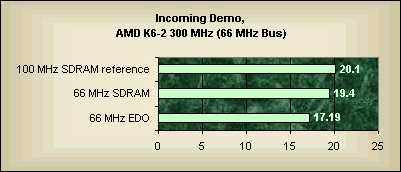K6-2 Performance Guide
Back To The Roots: 66 MHz Bus Speed
I can imagine that many people are considering to buy a K6 or K6-2 CPU to upgrade their system. Some older motherboards can be switched to 2.2 or 2.1 Volts, sometimes not described in the manual, and they might have a BF2 jumper as well. If then the manufacturer also provides a new BIOS on the website, you have the chance to upgrade the CPU. Many of you may ask whether this makes sense at "only" 66 MHz bus speed, since the K6-2 benefits substantially from the higher bus speed.
Let's get back to our reference performance with the 512 kB AOpen board:
The difference in Winstone between a K6-2 300 at 66 MHz x4.5 and the maximum performance at 100 MHz x3 is about 1.9 points, this is about 9% less with SDRAM and 13% with EDO DRAM.
Quake II runs about 14% slower on a 66 MHz system than on a system running at 100 MHz FSB. By the way, SDRAM memory is much better for the memory sensitive Quake II: A system equipped with EDO is approximately 16% slower. Again, using a powerful 3D card would compensate the smaller bandwidth of EDO.
The difference between 66 and 100 MHz bus clock with the 3D game Incoming is only about 3%. And you can see the better performance of SDRAM memory once more: In a standard 66 MHz computer using EDO instead of SDRAM has an effect on Incoming by 11%.
Get Tom's Hardware's best news and in-depth reviews, straight to your inbox.
Current page: Back To The Roots: 66 MHz Bus Speed
Prev Page 512 kB Or 1 MB 2nd Level Cache Next Page Summary Memory Speed
Patrick Schmid was the editor-in-chief for Tom's Hardware from 2005 to 2006. He wrote numerous articles on a wide range of hardware topics, including storage, CPUs, and system builds.


